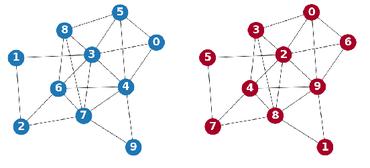Comparison of Brain Networks with Unknown Correspondences
Graph theory has drawn a lot of attention in the field of Neuroscience during the last decade, mainly due to the abundance of tools that it provides to explore the interactions of elements in a complex network like the brain. The local and global organization of a brain network can shed light on mechanisms of complex cognitive functions, while disruptions within the network can be linked to neurodevelopmental disorders. In this effort, the construction of a representative brain network for each individual is critical for further analysis. Additionally, graph comparison is an essential step for inference and classification analyses on brain graphs. In this work we explore a method based on graph edit distance for evaluating graph similarity, when correspondences between network elements are unknown due to different underlying subdivisions of the brain. We test this method on 30 unrelated subjects as well as 40 twin pairs and show that this method can accurately reflect the higher similarity between two related networks compared to unrelated ones, while identifying node correspondences.
PDF Abstract
